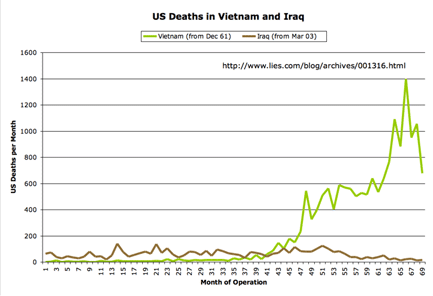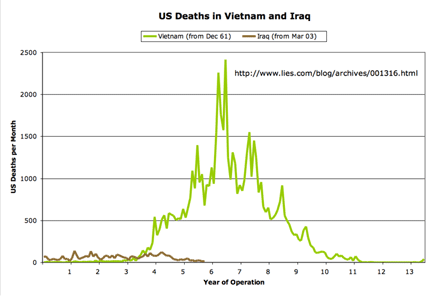U.S. Deaths in Iraq for April and May, 2007
Here are the updated graphs for April and May. As always, I’m comparing the US military casualties in Iraq to those from the Vietnam war at a similar point in each war’s political lifetime (which some have charged is misleading; see disclaimer below). The data come from the advanced search tool at the Vietnam Veterans Memorial Fund site, and from Lunaville’s page on Iraq coalition casualties. The figures are for the number of US dead per month, without regard to whether the deaths were combat-related.
The first graph shows the comparison for the extent of the Iraq war to-date. (Click on any image for a larger version.)
Next, the chart that gives the US death toll for the entire Vietnam war:
Disclaimer: I’ve been accused of comparing apples to oranges in these graphs. For the record, here’s what I am not arguing:
- I’m not saying that Iraq is somehow deadlier per soldier-on-the-ground than Vietnam. For both wars, the number of fatalities in any given month tracks pretty closely with the number of troops deployed (along with the intensity of the combat operations being conducted). There were more troops in Iraq in the early going than were in Vietnam during the “corresponding” parts of the graphs. Similarly, for later years in Vietnam, when the monthly death toll exceeds the current Iraq numbers, there were many more troops in place.
- I am not saying that Iraq is somehow “worse” than Vietnam. I include the first graph mainly because I wanted a zoomed-in view of the Iraq data. And I include the second graph, which shows the entire span of the Vietnam war, because I want to be clear about what the data show about overall death tolls — where any rational assessment would have to conclude that, at least so far, Iraq has been far less significant (at least in terms of US combat fatalities) than Vietnam.
I was just curious how the “death profile” of the two wars compared, and how those deaths played out in terms of their political impact inside the US. For that reason, I chose as the starting point for each graph the first fatality that a US president acknowledged (belatedly, in the case of the Vietnam graph, since US involvement in the war “began” under Kennedy, but the acknowledgement was made only later by Johnson) as having resulted from the war in question.
As ever, you are free to draw your own conclusions. And for that matter, you’re free to draw your own graphs, if you have a way of presenting the information that you believe would be better. In that case, feel free to post a comment with a URL to your own version. Thanks.



June 18th, 2007 at 10:40 pm
Care to superimpose estimates of civilian/charlie/raghead body counts on these graphs?
June 22nd, 2007 at 8:00 am
I’d be interested in doing so, if I had access to good numbers. So far I haven’t seen anything with that kind of month-by-month granularity. Instead we’ve got wildly unreliable body count figures reported by the military (which I’ve noticed have been making more of an appearance from Iraq lately — “60 suspected insurgents killed, according to a military spokesperson”), and the occasional overall estimates that vary dramatically based on the assumptions and biases of the people doing the estimating.
June 22nd, 2007 at 12:17 pm
Is the “surge” working? Lately, it appears that there are more deaths all around. Just yesterday I read that something like 14 US troops were killed in less than 48 hours.
Could it be that the “surge” produced what many had feared and some even predicted: just more targets for the resisters to attack?
June 23rd, 2007 at 9:01 pm
Hey jbc,
Sorry, my question was more rhetorical, just pointing out that there’s a lot more dying than shown in counting the military deaths. I’m told I have a keen sense of the obvious.
Whose life is worth more, an Iraqi civilian parent, an Iraqi civilian child, diplomatic corps American civilian, US Military grunt, Iraq military grunt, insurgent, a terrorist, or yours?
Another rhetorical question, unless of course you are shcb in which case you probably have a clear hierarchy as to who you would most want and least want to see blown to bits with shrapnel.
June 30th, 2007 at 7:39 pm
I’ve watched the body counts as well as I can and haven’t been able to make much of a determination either. It seems when I watch shows on the history channel, or see news reports where some indication is given, the ratio is about 10 to 1, which would be in historical perspective to the Pacific campaign in WW II and in Vietnam. This of course would be offset to some degree with IEDs and suicide bombers that would tip the count in favor of the enemy. We would tip it the opposite direction again with aerial assaults where American forces are at almost no risk. So…. I just call it 10 to 1. We will probably never know for sure. I don’t think they have the technology to keep accurate counts, which has to just drive their commanders crazy since all wars are wars of attrition. Our government also does it’s best to keep enemy dead accounts minimized since Uncle Walter and the rest of the liberal media used these numbers against our war effort in Vietnam. Traditionally body counts were a way to know if you were winning or loosing a war. Walter was able to use a high enemy death rate to garner support and sympathy for the enemy from Americans, hence we lost. We are trying to avoid deja vu all over again.
Of course I have a well defined sense of who I want to die. As with most people I wish to protect; myself, my family, friends, community, nation and allies. Any one that threatens those needs to be dealt with in whatever means are required. Of course the deaths of civilians should be minimized, that is what the fourth Geneva convention is all about. We are going way above and beyond what is required to protect our Iraqi friends while killing our and their enemies. It is our enemies that not only hide behind these civilians, but actually target them.
July 1st, 2007 at 11:32 pm
The shitty part is, no matter how much you try to minimize civillain casualties, one careless attack on innocents creates so much animosity that it probably negates months worth of ‘progress’.
July 2nd, 2007 at 4:38 am
You’re correct of course, the length of time it takes to recover from a mistake depends largely on how close you are the tragedy, was it your young daughter, your niece, or the kid a few miles over. It also depends on the ability of the person affected to separate their personal loss from the big picture. But what would the alternative be, anarchy, women loosing the right to vote, being beaten on the street for wearing the wrong cloths, watching your daughter raped in front of you.
It seems we are seeing a glimmer of hope that the Iraqis are finally understanding they have a limited time to get their act together or they will slide back to a totalitarian regime. I just hope it isn’t too late.